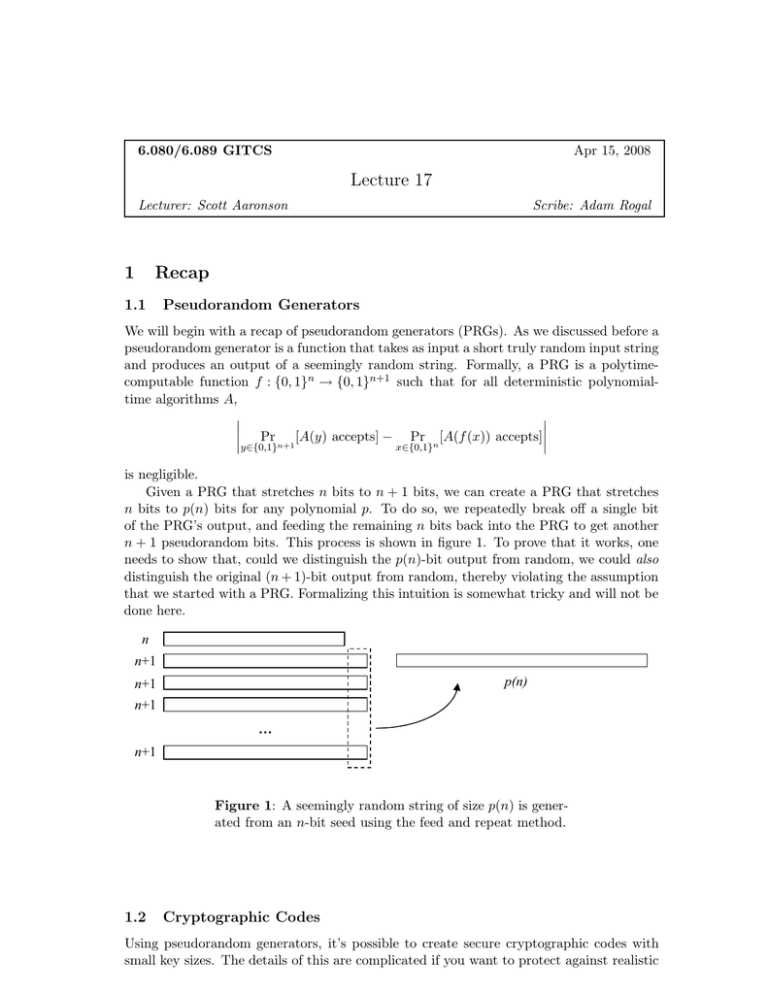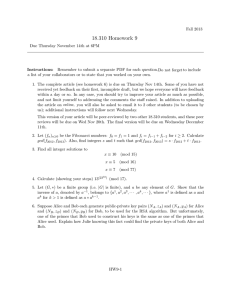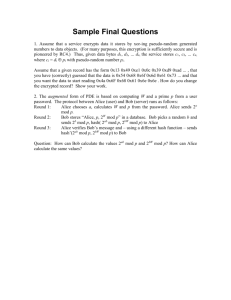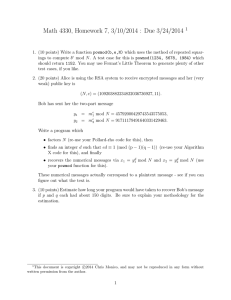Lecture 17 1 Recap 1.1
advertisement

6.080/6.089 GITCS
Apr 15, 2008
Lecture 17
Lecturer: Scott Aaronson
1
Scribe: Adam Rogal
Recap
1.1
Pseudorandom Generators
We will begin with a recap of pseudorandom generators (PRGs). As we discussed before a
pseudorandom generator is a function that takes as input a short truly random input string
and produces an output of a seemingly random string. Formally, a PRG is a polytime­
computable function f : {0, 1}n → {0, 1}n+1 such that for all deterministic polynomialtime algorithms A,
�
�
�
�
� Pr [A(y) accepts] − Pr [A(f (x)) accepts]�
�y∈{0,1}n+1
�
x∈{0,1}n
is negligible.
Given a PRG that stretches n bits to n + 1 bits, we can create a PRG that stretches
n bits to p(n) bits for any polynomial p. To do so, we repeatedly break off a single bit
of the PRG’s output, and feeding the remaining n bits back into the PRG to get another
n + 1 pseudorandom bits. This process is shown in figure 1. To prove that it works, one
needs to show that, could we distinguish the p(n)-bit output from random, we could also
distinguish the original (n + 1)-bit output from random, thereby violating the assumption
that we started with a PRG. Formalizing this intuition is somewhat tricky and will not be
done here.
n n+1
p(n)
n+1
n+1
…
n+1
Figure 1: A seemingly random string of size p(n) is gener­
ated from an n-bit seed using the feed and repeat method.
1.2
Cryptographic Codes
Using pseudorandom generators, it’s possible to create secure cryptographic codes with
small key sizes. The details of this are complicated if you want to protect against realistic
attacks (for example, so-called chosen-message attacks). But at the simplest level, the
intuition is the following: we should be able to simulate a one-time pad (which is provably
unbreakable when used correctly) by (1) taking a small random key, (2) stretching it to a
longer key using a PRG, and then (3) treating that longer key as the one-time pad. If a
polynomial-time adversary could break such a system, that would mean that the adversary
was distinguishing the PRG’s output from a truly random string, contrary to assumption.
1.3
One-Way Functions
In addition to PRGs, we’ll be interested in a closely-related class of objects called OWFs,
or one-way functions. An OWF is a polytime-computable function f : {0, 1}n → {0, 1}p(n)
such that for all deterministic polynomial-time algorithms A,
Pr
x∈{0,1}n
[f (A(f (x))) = f (x)]
is negligible.
Or in plainer language, an OWF is a function that’s easy to compute but hard to
invert.
1.4
Yao’s Minimax Principle
As a side note, you might wonder why we assumed the adversary A was determinisic
rather than probabilistic. The answer is that it makes no difference! If you’re playing
rock-paper-scissors, and you know the probability distribution over your opponent’s move,
then there’s always some fixed move you can make that does as well as any randomized
strategy. Similarly, one you fix the probability distribution over inputs – as we do with
PRGs and OWFs – there’s always a deterministic algorithm whose success probability is as
large as any randomized algorithm’s. This is (the easy part of) Yao’s Minimax Principle,
one of the most useful facts in theoretical computer science.
1.5
Relation Between PRGs and OWFs
Claim: Every PRG is also an OWF. Why? Because if we could invert a PRG, then it
wouldn’t be pseudorandom! We’d learn that there was some seed that generated the
output string, which would be true for a random string with probability at most 1/2.
In 1997, Håstad et al. proved the opposite direction: if OWFs exist then so do PRGs.
This direction was much, much harder (note that transformations of the OWF are neces­
sary, since it’s easy to give examples of OWFs that are not PRGs). Because of this result,
we now know that the possibility of private-key encryption with small keys is essentially
equivalent to the existence of OWFs.
2
2.1
Public-Key Cryptography
Abstract Problem
Suppose Alice is trying to send Bob a package, so that no third party can open it en route.
We’ll assume that boxes can be “locked,” in such a way that you can only open a box if
you have the right key.
If Alice and Bob share duplicates of the same key, then this problem is trivial: Alice
locks the box with her key and sends it to Bob, who then opens it with his key. But what
if Alice and Bob don’t share a key? Obviously, we don’t want Alice to send the package in
a locked box, and the key that opens the lock in an unlocked box! We seem to be faced
with an infinite regress.
Fortunately, there’s a simple solution. As shown in Figure 2, first Alice puts the
package in a box, locks it, and sends it to Bob. Then Bob puts a second lock on the box
and sends it back to Alice. Then Alice removes her lock and sends the box back to Bob.
Finally Bob removes his lock and opens the box.
Bob
Alice
$
A
A
$
A
$
B
$
A
B
$
B
$
B
$
$
Figure 2: The smarter approach has Alice and Bob passing
the package with at least one form of protection at all times.
This ensures that only Alice and Bob will be able to open
the package.
2.2
Diffie-Hellman
How could we simulate the above protocol, in the situation where Alice and Bob are
sending bits of information rather than physical boxes? The first serious proposal in the
open literature for how to do this was given by Diffie and Hellman in 1976.
Alice
Bob
mod
mod
mod
mod
mod
mod
mod
mod
mod mod
Figure 3: The Diffie-Hellman protocol for creating a shared
secret key K between Alice and Bob.
The process, shown in figure 3, begins by Alice choosing a large prime number, p, a
base, g, and a secret integer, a. Alice will calculate a public number A = g a mod p. She
will then send p, g, and A to Bob. Bob will then pick his own secret b, and send B = g b
mod p back to Alice. Finally, Alice calculates the secret key K as K = B a mod p, and
Bob calculates it as K = Ab mod p. They both now have the same key with which to
encode messages to each other.
We’ve seen that Diffie-Hellman is a simple way to exchange a key; yet, but it’s a bit
cumbersome in practice. What we’d really like is a public-key protocol that involves fewer
messages back and forth—and in which only one person, not two, needs to create public
and private keys.
3
RSA
RSA (together with its variants) is probably the most widely-used cryptographic pro­
tocol in modern electronic commerce. Much like Diffie-Hellman, it is built on modular
arithmetic.
3.1
How It Works
As shown in Figure 4, the process is more direct than with Diffie-Hellman. Let’s suppose
you want to send your credit card number to Amazon.com. Then in the simplest variant,
Amazon picks two large prime numbers, p and q, with the condition that neither p − 1 nor
q − 1 is divisible by 3. It then multiplies them together to get N = pq and sends N to
you. On retrieving N , you calculate y = x3 mod N , where x is your credit card number,
and send y back to Amazon.
Amazon
You
s.t. (p­1) and (q­1) are not
divisible by 3
Find s.t. Figure 4: RSA uses modular arithmetic to retrieve x ef­
ficiently from an encoded message. An eavesdropper will
only see N and x3 mod N .
Amazon then faces the problem of how to recover x given y. In other words, how does
it take a cube root modulo N? Fortunately, it can do that given using its knowledge of the
prime factors p and q, together with the following formula discovered by the mathematician
Leonhard Euler in the 1700’s:
x(p−1)(q−1) = 1 mod N
(Why is this formula true? Basically, because (p − 1)(q − 1) is the order of the multi­
plicative group mod N , consisting of all numbers from 1 to N that are relatively prime to
N . We won’t give a more detailed proof here.)
Euler’s formula implies that, if Amazon can only find an integer k such that 3k =
1 mod (p − 1)(q − 1), then
y k = x3k = xc(p−1)(q−1)+1 = x mod N,
where c is some integer. But the fact that neither p − 1 nor q − 1 is divisible by 3
implies that such an integer k must exist – and furthermore k can be found in polynomial
time given p and q, for example by using Euclid’s algorithm. And once Amazon has k,
it can also compute y k mod N = x in polynomial time using repeated squaring. It can
thereby recover your credit card number x, as desired.
The obvious question is, how secure is this system? Well, any adversary who could
factor N into pq could obviously decrypt the message x, by using the same algorithm that
Amazon itself uses. Hence this whole system is predicated on the presumed intractability
of factoring large integers (an assumption that would be violated if, for example, we built
large-scale quantum computers). And of course, any proof that factoring is hard would
also prove P 6= N P .
In the other direction, you might wonder: assuming the factoring problem is hard, is
RSA secure? Alas, that’s been an open problem for 30 years! Yet despite its uncertain
theoretical foundations, the RSA system has withstood all attacks thus far (unlike many
other proposed cryptosystems), and today millions of people rely on it.
MIT OpenCourseWare
http://ocw.mit.edu
6.045J / 18.400J Automata, Computability, and Complexity
Spring 2011
For information about citing these materials or our Terms of Use, visit: http://ocw.mit.edu/terms.






